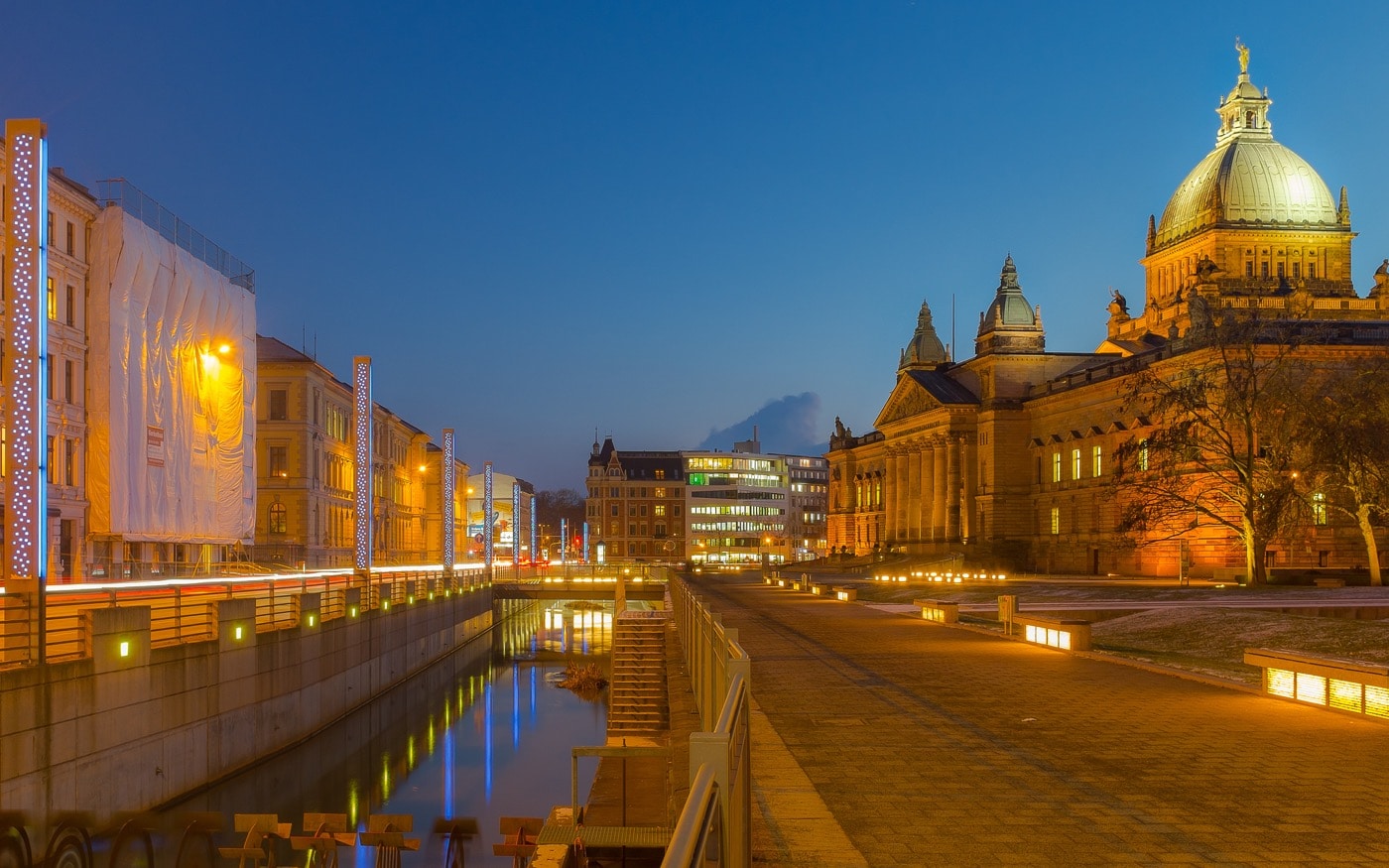When I lived in West Germany before the fall of the Berlin Wall, cities across the border in the Communist East Bloc seemed a world away. Any travel to East Germany was especially restricted, and the red tape required for visiting wasn’t worth the hassle. But all that has changed, as I discovered on a recent trip to Leipzig.
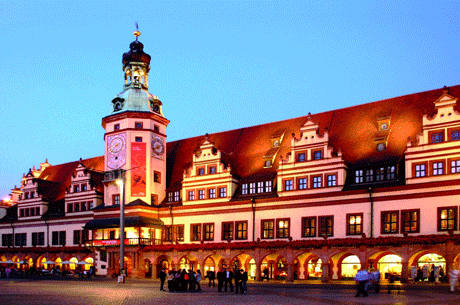
With the two Germanys reunited after the fall of the wall in 1989, travel to East Berlin opened up and the historic cities “across the border”—Leipzig one of them—began to renew and refurbish themselves after the damage from the war and four decades of Communist domination. Over the past 20 years Leipzig has again become a destination, as it was years ago when it was known for its intellectual and cultural life. It’s a metropolis that grew rich from hosting international trade fairs, publishing books, and processing cotton. Now, fast forward to today, the New York Times has included Leipzig on its list of top ten cities to visit.
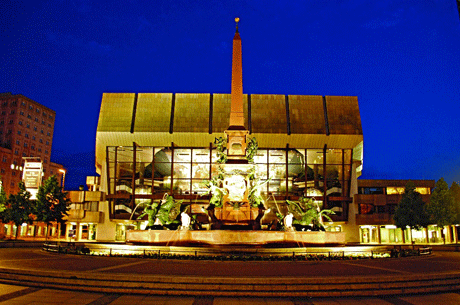
The history of the city is written not only in its archives but also in its architecture, from the 13th-century St. Thomas Church to the numerous handsome 19th-century Gründerzeit buildings, to the functional Plattenbau pre-fab concrete constructions of post-World-War II and finally to the shiny and modern facade of the university’s main building on Augustusplatz, a glass-and-steel edifice dedicated to learning. Although Leipzig is a work in progress, the contrast between old and new, functional and decorative, elegant and unrefined, is part of the city’s charm.
Start by exploring the historic central city from the ring road that encircles it. Plan on visiting this “core” of Leipzig on foot, as most streets are closed to cars and trucks, except the occasional taxi or delivery van. Bicycles are the preferred mode of transportation in Leipzig, so watch carefully every time you cross a street, even in the pedestrian zone. Leipzig also has an excellent public transportation system, with trams and buses that take you around the ring road and beyond, to the greater part of the city and sights outside the center.
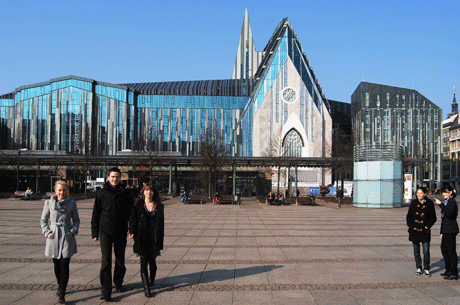
The best way get your bearings is to take the elevator up to the top of the 400 feet high Leipzig Panorama Tower on the Augustusplatz, the city’s tallest building, for a stunning 360º view of the city center and the outlying area. If all that height makes you hungry, have lunch at the Panorama Restaurant “Plate of Art,” which features four dining areas that look out over different sections of the city. Then descend to the ground level to begin your sightseeing tour.
It’s fun to just wander around the historic city center on foot, taking in whatever serendipity sends your way, from classic buildings to cozy cafes to funky street mimes. But a good way to approach many-faceted Leipzig is to pick a particular area of interest to you and visit the specific sites associated with it. History buffs will want to start at the Altes Rathaus (Leipzig’s Old City Hall), a beautiful Renaissance edifice dating from the mid-1500s. Inside you’ll find a fascinating museum of the city’s history, including the Luther Room, with artifacts relating to the great religious reformer of the 1500’s, who visited Leipzig several times. Outside the city center, the massive Monument to the Battle of the Nations commemorates Napoleon’s defeat there in 1813, in a decisive battle fought by 600,000 soldiers from all over Europe.
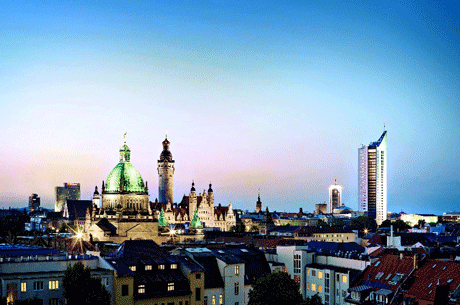
Anyone interested in modern history should not miss St. Nicholas Church, considered to be the birthplace of peaceful protests against the communist government (the German Democratic Republic, or GDR) in the 1980s. Leipzig prides itself, rightly so, for its part in helping to bring down the repressive GDR government in 1989. To learn more about what life was like in the GDR, and how the peaceful revolution changed the Germans’ world that year, be sure to visit the Forum of Contemporary History, an excellent museum with extensive exhibits ranging from the end of World War II to German reunification in 1990. Another related site is the Museum in der Runde Ecke (Museum in the Round Corner), located in the former district headquarters of the dreaded East German State Security Service, the so-called “Stasi” or secret police.
Music lovers will delight in Leipzig’s numerous places associated with famous musicians from medieval to modern times. Leipzig was a magnet for composers from Bach to Mozart, Mendelssohn, Wagner, Grieg, the Schumanns, Mahler, and many more. Start at St. Thomas Church, home of the famous St. Thomas Boy’s Choir that was founded a thousand years ago, in 1012. Johann Sebastian Bach was director of the choir from 1723 to 1750, and also conducted other choirs in Leipzig during that time. The Bach Museum, across from the church, offers interactive exhibits about the composer’s life and works, as well as an extensive music and document archive. On the Augustusplatz, the Leipzig Opera House, home of Europe’s third-oldest opera company, faces the contemporary Gewandhaus Concert Hall, home of the world-renowned Gewandhaus Orchestra. Its conductor Kurt Masur, was also a leading light in the peaceful revolution of 1989. In keeping with its musical heritage, Leipzig hosts numerous festivals throughout the year, from the Leipzig Bachfest to Wave-Gotik-Treffen, one of the world’s largest Gothic festivals, with 150 groups playing music from medieval to new-wave punk.
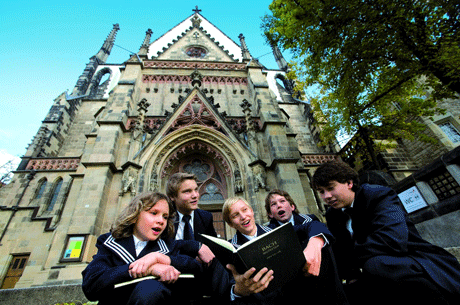
Connoisseurs of art will find plenty to see in Leipzig. The Museum of Fine Arts displays an outstanding collection of paintings, drawings, and sculptures, including works by Lucas Cranach, Peter Paul Rubens, Max Beckmann, and many others. The recently restored GRASSI Museum complex houses three different museums, each very interesting in its own right: Applied Arts and Crafts, Ethnology, and Musical Instruments. For a different art experience, head out to the former industrial district of Lindenau in the southwestern part of the city. The big attraction here is the Spinnerei, a group of contemporary art galleries and artists’ workshops inside a huge red-brick cotton mill, once the largest factory of its kind in continental Europe. Nearby, the Plagwitz district is another industrial area where factories and former workers’ quarters are being restored or renovated as art galleries, restaurants, clubs, and attractive apartments for hip young families.
Lovers of literature will want to visit the Schiller House, home of Friedrich Schiller, the 18th-century German poet and playwright. And who could go to Leipzig without dining downstairs at the Auerbachs Keller, the historic tavern where Johann Wolfgang von Goethe set a key scene in his drama, “Faust”? Get away from matters of the mind by wandering outdoors through the greenery of Leipzig’s Zoo, just outside the busy city center, with its 850 species of animals, many of them living in natural habitats. A new attraction is the recently opened Gondwanaland, an enclosed rain forest with dozens of tropical plants and exotic animals from three continents, as well as the on-site restaurant Marché Patakan serving a selection of dishes from south Asian countries.
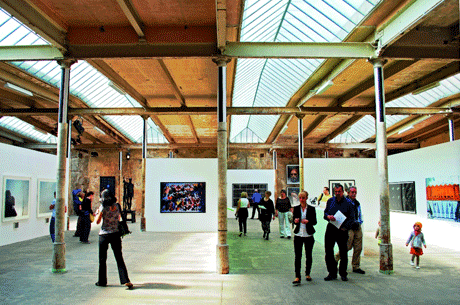
Wherever you end up in Leipzig, all that sightseeing is bound to have worked up your appetite. You’ll find plenty of places to eat in the city center, including the historic Thüringerhof and Bartelshof restaurants, both known for their for good down-home regional food; the traditional Ratskeller, in the basement of the New Town Hall, a huge, handsome neo-gothic municipal government building dating from 1905; Zum Arabischen Coffe Baum, one of the oldest continually operating coffeehouses and restaurants in Europe; and the Gasthaus & Gosebrauerei Bayerische-Bahnhof, the brewery-restaurant of Leipzig’s special top-fermented, unfiltered wheat beer flavored with coriander.
Nightlife in Leipzig centers on two main areas, in addition to the always lively university district around the Moritzbastei. Just off the Marktplatz, the Barfussgässchen is a block-long pedestrian street of restaurants and sidewalk cafes, now mainly serving the tourist trade. For the funkier, more fun side of Leipzig, head south from the ring road to the Karl-Liebknecht-Strasse, with its several blocks of restaurants, cafes, and taverns serving foods and drinks from Turkey, Spain, Mexico, Russia, Ireland, the Czech Republic, France, and yes, even Germany. During the daytime, this is a lively arts-district neighborhood, too, reminiscent of 1960s hippie America.
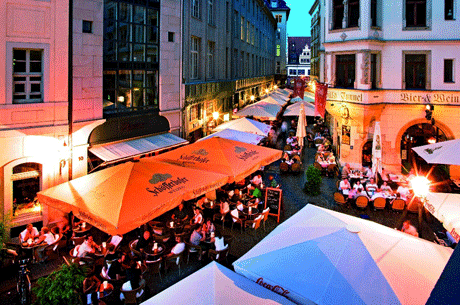
Where to Stay:
Steigenberger Grandhotel Handelshof – Opened in 2011, this luxurious modern hotel (a 5-star-superior member of the renowned Steigengberger hotel chain) occupies a historic stone building in the old city center, within walking distance of all the main sights. In addition to its 163 Superior and Deluxe rooms and 14 suites, the hotel includes an attractive bar, a gourmet restaurant (Brasserie Le Grand), a vinotheque, a spa, and a fitness center. Salzgässchen 6, tel. 341-350-5810, www.leipzig.steigenberger.com.
Hotel Fürstenhof – Another 5-star-superior hotel (a member of the Starwood Luxury Collection), the Fürstenhof is located in a former patrician palace built in 1770. Experience Old World elegance in the neoclassical lobby and 19th-century opulence in the historic red and gold decorated “Serpentine Hall” whose walls are lined with the semi-precious stone. Enjoy eating at the hotel’s Wintergarten Bar, Vinotheque 1770, and gourmet Restaurant Villers, and then relax in the pretty pool and modern sauna in the basement. Tröndlinring 8, tel. 341-1400, www.hotelfuerstenhofleipzig.com.
Pentahotel Leipzig – This quirky, modern 4-star hotel belonging to the Penta chain is located in a quiet residential area just a couple of blocks outside the ring road that encircles Leipzig’s historic city center. The 365 air-conditioned rooms are decorated in contemporary style, but the woody “club lounge” on the first floor feels like an English gentlemen’s retreat, and the lobby sports both a hip bar and a cozy sitting area with a circular shelf of books for you to peruse. Grosser Brockhaus 3, tel. 341-1292-0, www.pentahotels.com/leipzig.
Where to Eat & Drink:
Falco – With two Michelin stars and a superb view over the city, this fine restaurant on the 27th floor of the Westin Hotel offers ultra-modern food in a sleek, cool, contemporary setting. In addition to the à la carte offerings, there are also prix fix menus priced at €144 for 5 courses and €179 for 7 courses. Gerberstrasse 15, tel. 341-988-2728, www.falco-leipzig.de.
Restaurant Stadtpfeiffer – Located in Leipzig’s famous Gewandhaus Concert Hall, the Michelin 1-star-rated Stadtpfeiffer is another very modern restaurant with artistically plated food to match. Try the 6-course prix fixe menu (€106) featuring several of the restaurant’s well known specialties. Augustusplatz 8 (inside the Gewandhaus), tel. 341-217-8920, www.stadtpfeiffer.de.
Auerbachs Keller – No visitor should leave Leipzig without eating in the famous Auerbachs Keller, a historic old tavern that has been selling food and drinks since 1525. Dine on Saxon specialties in the Grosse Keller, the big dining room that seats 500, or seek out the older parts of the restaurant, including the Goethe Room and the Luther Room, both associated with those luminaries from the past. Mädler-Passage, Grimmaischer Strasse 2 – 4 , tel. 341-216-100, www.auerbachs-keller-leipzig.de.
*Bargain Tip: Buy a 1-day Leipzig Card (€8.90) or 3-day card (€18.50) for unlimited travel on the buses and trams, as well as discounts on sightseeing tours, tickets for cultural events, and meals at selected restaurants. Sold at the city tourist offices (Katharinenstrasse 8, Augustusplatz 9) and several other locations, including the main train station.

